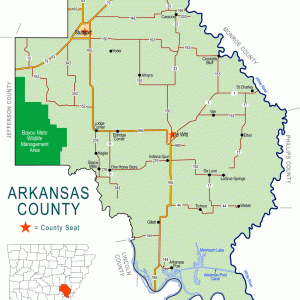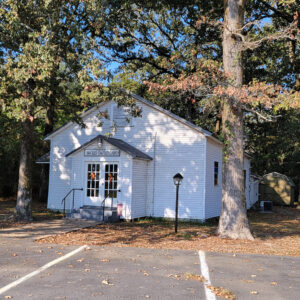calsfoundation@cals.org
Hagler (Arkansas County)
The community of Hagler was likely not populated until after the Civil War, though the Hagler family, after whom the community was named, came to Arkansas in the late 1840s, settling throughout Arkansas County. By 1878, tax assessments list W. G. R. Hampton, William A. Crockett, Robert Hagler, and Jacob Hagler as living in the Hagler community. Deeds indicate that William Graves purchased much land around the Hagler community after the war; he established the first known store in the area. In 1888, a petition was circulated by Robert L. Hagler for a post office, and he became the first postmaster. The store established by Graves closed in the late 1880s, and its clerk, John Scott, bought eighty acres up the road and opened a room in his house as a store. Court records tell of another local store owned by H. M. Simpson & Co. that went out of business and had its goods auctioned off at John Scott’s store in 1902.
The earliest known records of the church at Hagler date back to the 1870s. It was then called New Hope No. 2 and was probably a break off from New Hope No. 1 located at DeWitt (Arkansas County). On July 6, 1910, a deed was made by Willie Irene Graves Cummings to the trustees of New Hope Baptist Church for ground “to be used as a building site for New Hope Baptist Church.” This is the site of the present-day Hagler Southern Baptist Church. Church records indicate that this building was erected in about 1911 and cost $600.
Arkansas County records indicate that the first school was built on land deeded to the Hagler Special School District No. 27 on August 29, 1885. Jane Scott Howard, who later taught school there, recalled that the original building was a log room before the one-room frame building in which she taught was built. On June 25, 1917, the school district sold the original school land and road right-of-way to James E. Cook for $165. The second Hagler school, which was located on the east side of the Goldman/Cooper Ferry Road, was likely erected in about 1915. A barber shop, John Scott’s store, and the school were located at this site, though the school was disbanded in 1949 and sold to John H. Hampton.
The Billings Cemetery on Hagler Road west of the Baptist church was on the Robert Billings place. The last person buried in the Billings Cemetery was reportedly Elijah Chaddic, interred about 1910.
The Flood of 1927 moved people out of the Brewer Bottoms area and up to the higher ground around Hagler. Some people were housed in the Hagler school during the flood.
A favorite pastime around Hagler was to go to Mozier Ford on Bayou Meto to fish or dig mussels. Hunters from the northern United States came to the Hagler area for duck hunting, giving locals an added source of income serving as guides in the reservoirs and bayous. Among those who hunted in the area was famed sportswriter Grantland Rice.
The general store at Hagler was the focus of the community and was known to sell supplies for making moonshine. Writer Earnest L. Best later recalled working for Charley North, a local farmer and moonshiner, and making deliveries of grain bought at the store to other known moonshiners, who would pay their bills after they had sold their product.
The Hagler post office was moved and its name changed to Lodge Corner in 1945. It finally closed in 1955. The Baptist church and cemetery are all that remain of the town in the twenty-first century. Only a handful of families live in the area. Duck hunting along the Mississippi Flyway remains popular, especially in the nearby Bayou Meto Wildlife Management Area. Many reservoirs in the Hagler area are used for the irrigation of rice crops and as places to hunt ducks in the winter.
For additional information:
Hagler, John Lafayette. “Grandad’s Christmas Gift.” Grand Prairie Historical Society Bulletin 35 (October 1992): 43–56.
Kennedy, W. L. (Pink). “A Narrative History of Arkansas County.” Grand Prairie Historical Society Bulletin 25 (October 1982): 27–30.
Rick and Judy Hampton
Hagler, Arkansas
 Arkansas County Map
Arkansas County Map  Hagler Church
Hagler Church  Hagler Street Scene
Hagler Street Scene 




Comments
No comments on this entry yet.